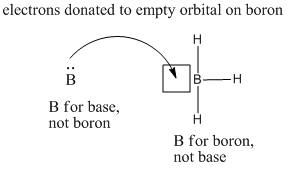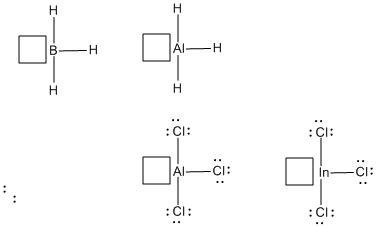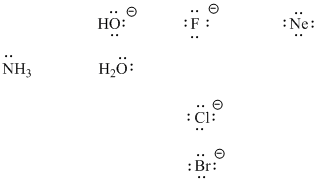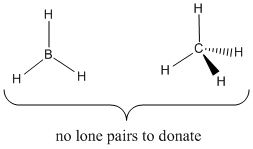2.11 Acids and Bases: The Lewis Definition
- Page ID
- 44178
Objectives
After completing this section, you should be able to:
- state the Lewis definition of an acid and a base.
- identify a given compound as being a Lewis acid or Lewis base, given its Lewis structure or its Kekulé structure.
Key Terms
Make certain that you can define, and use in context, each of the key terms listed below.
- Lewis acid
- Lewis base
Study Notes
The Lewis concept of acidity and basicity will be of great use to you when you study reaction mechanisms. For example, the realization that an ion such as
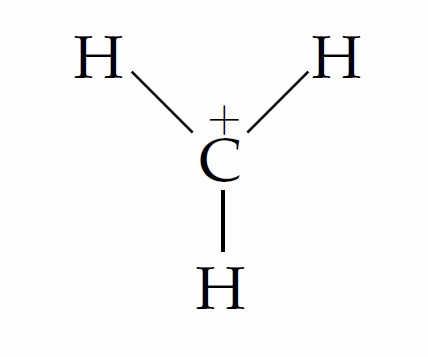
is electron deficient, and is therefore a Lewis acid, should help you to understand why it will react with substances which are Lewis bases (e.g., H2O).
The Brønsted-Lowry picture of acids and bases as proton donors and acceptors is not the only definition in common use. A broader definition is provided by the Lewis theory of acids and bases, in which a Lewis acid is an electron-pair acceptor and a Lewis base is an electron-pair donor. This definition covers Brønsted-Lowry proton transfer reactions, but also includes reactions in which no proton transfer is involved. The interaction between a magnesium cation (Mg+2) and a carbonyl oxygen is a common example of a Lewis acid-base reaction. The carbonyl oxygen (the Lewis base) donates a pair of electrons to the magnesium cation (the Lewis acid).
As we will see in chapter 11 when we begin the study of reactions involving carbonyl groups, this interaction has the very important effect of increasing the polarity of the carbon-oxygen double bond.
The Brønsted-Lowry equivalent of the reaction above is simply protonation of the carbonyl group. This, too, has the effect of increasing the polarity of the carbonyl double bond.
While it is important to be familiar with the Lewis definition, the focus throughout the remainder of this chapter will be on acid-base reactions of the Brønsted-Lowry type, where an actual proton transfer event takes place.
Lewis Acids
Borane is unusual because it is a compound without an octet. The central boron atom has only six valence electrons. It needs one more pair of electrons to obtain an octet. The boron is a Lewis acid.
Figure 2.11.1: Borane is a Lewis acid. It can accept electrons from a donor atom. The square drawn beside the boron is used to reinforce the idea that there is a vacant site for electrons there.
- Lewis acids are often short of a complete octet.
In the main group of the periodic table, atoms in the Group 13 column (including boron and aluminum) have three valence electrons to share in order to make bonds. Sharing these electrons with three electrons from neighbors would make three bonds, and provide six electrons, not eight, in the valence shell. Another pair of electrons must be accepted from a donor to achieve an octet.
Figure 2.11.2: Boron, aluminum and indium are from the same column of the periodic table. All three are often Lewis acidic; they can accept electrons from donors.
- Boron, aluminum and indium compounds are often Lewis acids.
The eight-electron rule does not hold throughout the periodic table. In order to obtain noble gas configurations, some atoms may need eighteen electrons in their valence shell. For example, transition metals such as titanium often follow an eighteen-electron rule. Titanium has four valence electrons and can form four bonds in compounds such as titanium tetrakis (isopropoxide), below, or titanium tetrachloride, TiCl4. However, the titanium atom in that compound has only eight valence electrons, not eighteen. It can easily accept electrons from donors.
Figure 2.11.3: Although titanium has eight electrons in this molecule, titanium tetrakis(isopropoxide), it can accommodate up to eighteen. It is Lewis acidic. The cerium atom in cerium tris(dimethylamide) comes from a similar part of the periodic table and is also Lewis acidic.
- Transition metals such as titanium, iron and nickel may have up to eighteen electrons and can frequently accept electron pairs from Lewis bases. Transition metals are often Lewis acids.
- Lanthanides such as cerium and samarium could conceivably have up to thirty-two electrons in their valence shells! They never do. However, they are usually strong Lewis acids.
Positive ions are often Lewis acids because they have an electrostatic attraction for electron donors. Examples include alkali and alkaline earth metals in the group IA and IIA columns. K+, Mg2+ and Ca2+ are sometimes seen as Lewis acidic sites in biology, for example. These ions are very stable forms of these elements because of their low electron ionization potentials. However, their positive charges do attract electron donors.
Figure 2.11.4. A calcium ion essentially has a noble gas configuration. Nevertheless, its positive charge can attract electrons from a donor atom.
In a similar way, "early" transition metals -- those that are close to the left hand side of the periodic table, especially in groups IIIB, IVB and VB -- have low ionization potentials and have high positive charges or oxidation states. For example, Sc3+, Zr4+ and V5+ are common forms of some early transition metals, and they are strong Lewis acids.
Figure 2.11.5: A few alkali, alkaline earth and transition metals that are commonly found as cations.
-
Many cations such as Ca2+ or Sc3+ are good Lewis acids. Their positive charges attract electrons.
The Proton as A common Lewis Acid
Perhaps the most common example of a Lewis acid or electrophile is also the simplest. It is the hydrogen cation or proton. It is called a proton because, in most hydrogen atoms, the only particle in the nucleus is a proton. If an electron is removed to make a cation, a proton is all that is left.
- H+ is a very common Lewis acid or electrophile.
A proton is electrophilic for a couple of reasons. It has a positive charge, and so it will attract electrons, which are negative. Also, it lacks the electron configuration of its noble gas neighbor, helium. Helium has two electrons. If a Lewis base or nucleophile donates a pair of electrons to a proton, the proton will obtain a Noble gas configuration. That's part of the reason why, in some periodic tables, hydrogen is shown in two places: at the very left, illustrating its potential to lose an electron, like sodium and lithium; and at the right, illustrating its potential to take on helium's configuration.
Figure 2.11.6: Proton as Lewis acid.
There is something about hydrogen cations that is not so simple, however. They are actually not so common. Instead, protons are generally always bound to a Lewis base. Hydrogen is almost always covalently (or datively / coordinately) bonded to another atom.
Many of the other elements commonly found in compounds with hydrogen are more electronegative than hydrogen. As a result, hydrogen often has a partial positive charge. Remember, that is one of the reasons that atoms can act as Lewis acids: with a partial positive charge, an atom becomes electrophilic.
Our statement about protons might better be expressed as:
- H+ is a very common Lewis acid or electrophile.
Figure 2.11.7. Proton transfer from one site to another.
If hydrogens are almost always bonded to other atoms, then the Lewis acid-base interactions we have looked at so far are slightly different here. Instead of two compounds coming together and forming a bond, we have one Lewis base replacing another at a proton.
- Protons are transferred from one basic site to another.
- Transfer occurs by donation of a lone pair to the proton.
Lewis Bases
What makes a molecule (or an atom or ion) a Lewis base? It must have a pair of electrons available to share with another atom to form a bond. The most readily available electrons are those that are not already in bonds. Bonding electrons are low in energy. Non-bonding electrons are higher in energy and may be stabilized when they are delocalized in a new bond.
Lewis bases usually have non-bonding electrons or lone pairs.
Lewis bases may be anionic or neutral. The basic requirement is that they have a pair of electrons to donate. Examples of Lewis bases include halide ions such as bromide or chloride. To the right of the halides in the periodic table are Noble gases such as neon. Noble gases do have lone pairs, but are stable enough that they do not usually react. They are not very good Lewis bases. To the left of the halides, however, are other examples in oxygen and nitrogen compounds. Water also has lone pairs and is a common Lewis base, and so is hydroxide ion, HO-.
Figure 2.11.2: Some examples of Lewis basic ions and molecules. Note that neon, although it has nonbonding electron pairs or lone pairs, does not usually act as a Lewis base.
- Halides, water, ammonia and hydroxide ion are examples of Lewis bases.
One column further to the left in the periodic table from nitrogen is carbon. Carbon does not normally have a lone pair. For example, methane, CH4, has all of its valence electrons in bonding pairs. These bonding pairs are too stable to donate under normal conditions. Methane is not a Lewis base.
Figure 2.11.3. Carbon and boron "hydrides". Neither of these compounds has a lone pair, and neither is a good Lewis base.
Even further to the left is boron. A simple boron compound is borane, BH3. Borane has no lone pairs; all its valence electrons are in bonds. Boron is not a good Lewis base.
Problem
Which of the following compounds appear to be Lewis bases?
a) SiH4 b) AlH3 c) PH3 d) SH2 e) -SH
Lewis Acid-Base Complexes
What happens when a Lewis base donates a pair of electrons to a Lewis acid? The arrow formulism we have been using to illustrate the behaviour of Lewis acids and Lewis bases is meant to show the direction of electron movement from the donor to the acceptor. However, given that a bond can be thought of as a pair of electrons that are shared between two atoms (in this case, between the donor and the acceptor), these arrows also show where bonds are forming.
Figure AB4.1. Donation of electrons from a Lewis base to a Lewis acid.
The electrons donated from a Lewis base to a Lewis acid form a new bond. A new, larger compound is formed from the smaller Lewis acid and Lewis base. This compound is called a Lewis acid-base complex.
A simple example of Lewis acid-base complexation involves ammonia and boron trifluoride. The nitrogen atom has a lone pair and is an electron donor. The boron has no octet and is an electron acceptor. The two compounds can form a Lewis acid-base complex or a coordination complex together.
Figure AB4.2: Formation of a Lewis acid-base complex from ammonia and boron trifluoride.
When the nitrogen donates a pair of electrons to share with the boron, the bond that forms is sometimes called a coordinate bond. Another term for this kind of bond is a dative bond. A coordinate or dative bond is any covalent bond that arose because one atom brought a pair of its electrons and donated them with another.
There is another piece of terminology you should get used to here. Sometimes, the electron donor is called a nucleophile and the electron acceptor is called an electrophile. Ammonia is a nucleophile and boron trifluoride is an electrophile.
- Because Lewis bases are attracted to electron-deficient atoms, and because positive charge is generally associated with the nucleus of an atom, Lewis bases are sometimes refered to as "nucleophiles". Nucleophile means nucleus-loving.
- Because Lewis acids attract electron pairs, Lewis acids are sometimes called "electrophiles". Electrophile meanse electron-loving.
Lewis acid-base complexes frequently have very different properties from the separate compounds from which they were formed. For example, titanium tetrachloride is a yellow liquid at room temperature. It is so Lewis acidic that it reacts with moisture in the air, undergoing a reaction that generates HCl gas in the form of white smoke. Tetrahydrofuran (or THF), a mild Lewis base, is a colourless liquid. When THF and TiCl4 are combined, a Lewis acid-base complex is formed, TiCl4(THF)2. TiCl4(THF)2 is a yellow solid at room temperature. Although it still reacts with the air, it does so very slowly, and shows no visible change when exposed to the air for several minutes.
Figure AB4.5: A Lewis acid-base complex between tetrahydrofuran (THF) and titanium tetrachloride.
Problem 1
Show, using arrow notation, the reaction between THF and titanium tetrachloride to form the Lewis acid-base complex, TiCl4(THF)2. Also show the structures of the complexes formed.
Problem 2
A similar Lewis acid-base complex is formed between THF and borane, BH3.
- Which compound is the Lewis acid? Which one is the Lewis base?
- Which atom in the Lewis acid is the acidic site? Why?
- Which atom in the Lewis base is the basic site? Why?
- How many donors would be needed to satisfy the acidic site?
- Show, using arrow notation, the reaction to form a Lewis acid-base complex.
- Borane is highly pyrophoric; it reacts violently with air, bursting into flames. Show, using arrow notation, what might be happening when borane contacts the air.
- Borane-THF complex is much less pyrophoric than borane. Why do you suppose that is so?
Problem 3
When a neutral Lewis acid combines with an anionic Lewis base, the product is called a complex ion. The same is true if a cationic Lewis acid combines with a neutral Lewis base.
Show the formation of the following polyatomic anions from the Lewis acid-base pairs that were combined in each case.
a) BF4- b) PF6- c) AlCl4- d) AlH4- e) Ag(NH3)2+
Contributors
Dr. Dietmar Kennepohl FCIC (Professor of Chemistry, Athabasca University)
Prof. Steven Farmer (Sonoma State University)
Chris P Schaller, Ph.D., (College of Saint Benedict / Saint John's University)
Organic Chemistry With a Biological Emphasis by Tim Soderberg (University of Minnesota, Morris)


